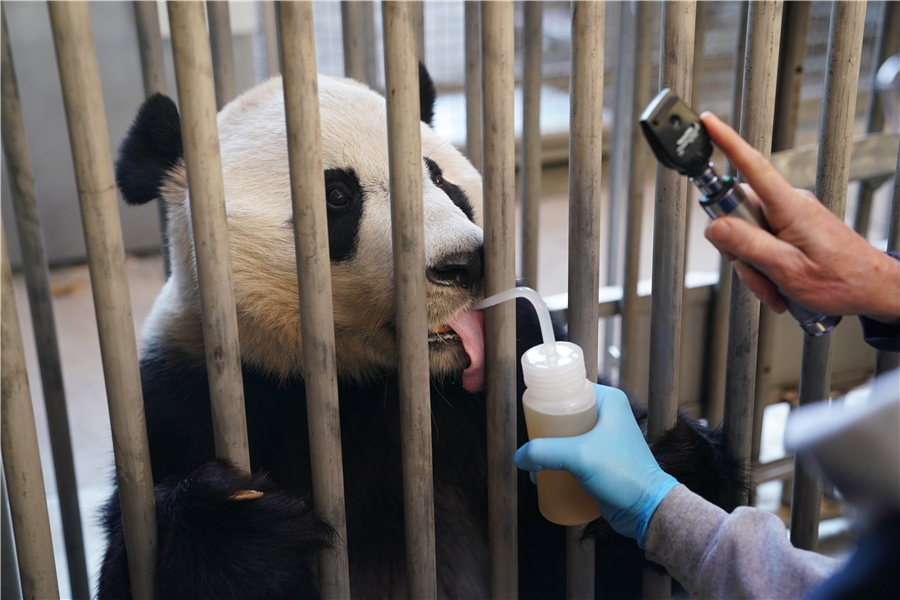
Bei Bei undergoes a physical checkup on Nov 13 before leaving the Smithsonian's National Zoo and Conservation Biology Institute in Washington on Tuesday. [Photo/Xinhua]
Four-year stay in United States ends for Bei Bei It was nearly 4 pm on Monday, time for the indoor giant panda habitat at the Smithsonian's National Zoo and Conservation Biology Institute in Washington to be cleaned by keepers. But dozens of visitors still lingered at the glass enclosure where 4-year-old male Bei Bei was playing. They were following every move of the bear, ahead of his imminent departure. As the animal was scheduled to leave for Chengdu, Sichuan province, on Tuesday, one video blogger from Los Angeles livestreamed footage of Bei Bei foraging in the den and eating a carrot, the animal's last meal in public in the United States. Thousands of visitors joined "Bye Bye, Bei Bei", the zoo's weeklong celebratory event, to bid farewell to the "American Sweetheart", as he is known by some. When he arrives in China on Wednesday, he will be in the care of Su Lingxiao during a 30-day quarantine period. Su, 25, works as a keeper at the China Conservation and Research Center Base for the Giant Panda in Ya'an, Sichuan province. As a young girl, Su raised rabbits in her home village in Longchang county, Sichuan. Su, who majored in animal medicine at Jilin Agricultural Science and Technology University, has worked at the base since completing her university studies in 2016. Her duties include placing bundles of bamboo in panda pens and clearing away droppings. "I feel very nervous because Bei Bei has received a lot of attention. But I think I can do well as I have accumulated a lot of experience in panda management," Su said. "I have taken care of about 10 pandas (at the base)."
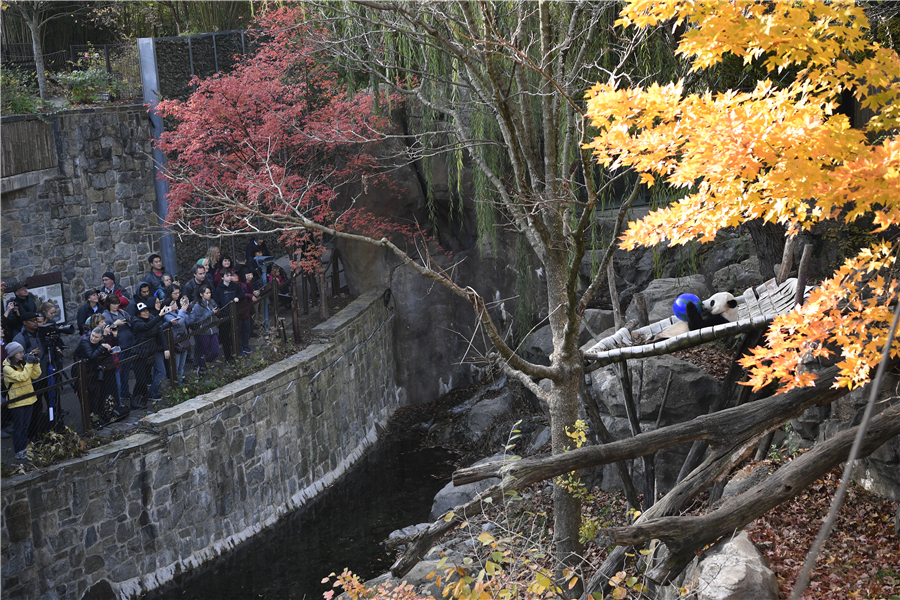
Visitors join "Bye Bye, Bei Bei", a weeklong celebratory event at the Smithsonian's National Zoo, to bid farewell to the panda. [Photo/Xinhua]
Days before Bei Bei's scheduled arrival, Su disinfected the quarantine enclosure where he will stay. It has been vacant since April, when two pandas, Ru Yi and Ding Ding, completed their monthlong quarantine and headed for the Moscow Zoo in Russia for a 15-year scientific program.
Cheng Yanxi, a 39-year-old veterinarian at the base, said a flame was used to briefly burn corners and cracks in the wall in a 20-square-meter den-areas difficult to reach with disinfectants. A major in animal medicine from Southwest Agricultural University in Chongqing, Cheng has worked at the base since 2004. He does not know how many pandas sent to the base from overseas he has cared for, but said the routine for their 30-day quarantine never changes. The animals have a blood test to determine if they have any liver or kidney problems, or if they have a protein deficiency. Since joining the base, Cheng has not encountered any major problems with any of the pandas arriving from overseas during their quarantine, and thinks that Bei Bei will not have any difficulty adapting to his new surroundings. Food, water and temperature are important factors in whether pandas can adapt to a new environment. "Sichuan has dozens of bamboo species. Our base alone can provide at least five species for Bei Bei to choose from, whereas overseas, there may be only one or two species available," Cheng said. "There is no industry in the mountains where the Bifengxia base is located and the water quality is good," he added.
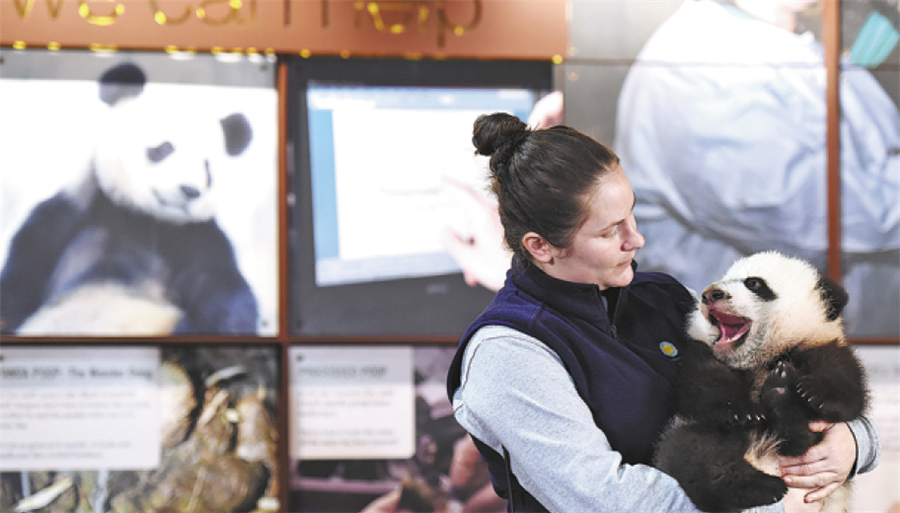
Bei Bei is displayed at a news conference at the zoo in December 2015, four months after his birth. [Photo/Agencies]
At the Washington zoo on Monday, Cindy Gordon, who lives in the US capital, was taking photos with her smartphone. Tears streamed down her cheeks as she and other visitors finally had to leave at the repeated request of zoo workers. "I feel so sad that Bei Bei is leaving," she said "He was the first panda I have ever bonded with when I moved here from New York." Gordon said she had visited Bei Bei more than 40 times over the past four years and liked watching him do somersaults in the snow. "The pandas live alone-they are so isolated-but Bei Bei seems to be so content and happy. So, when I moved here and I was feeling lonely, I looked at Bei Bei, and saw he was very happy to be on his own." An area is being set up next to Bei Bei's outdoor habitat for well-wishers to write post cards to him in China. Gordon wrote on hers: "We are so sad that you're leaving (Washington) DC, but we're excited for the next chapter in your life. We hope you love your new home in China, and we hope to visit you there some day. Thank you for being our friend." In recent weeks, panda keepers at the zoo have been making preparations to ensure Bei Bei is comfortable and safe during the 16-hour journey to China. According to a statement from the zoo, the preparations included getting the cub used to a travel crate; first by training him to walk through it, then spending time inside with the door closed. 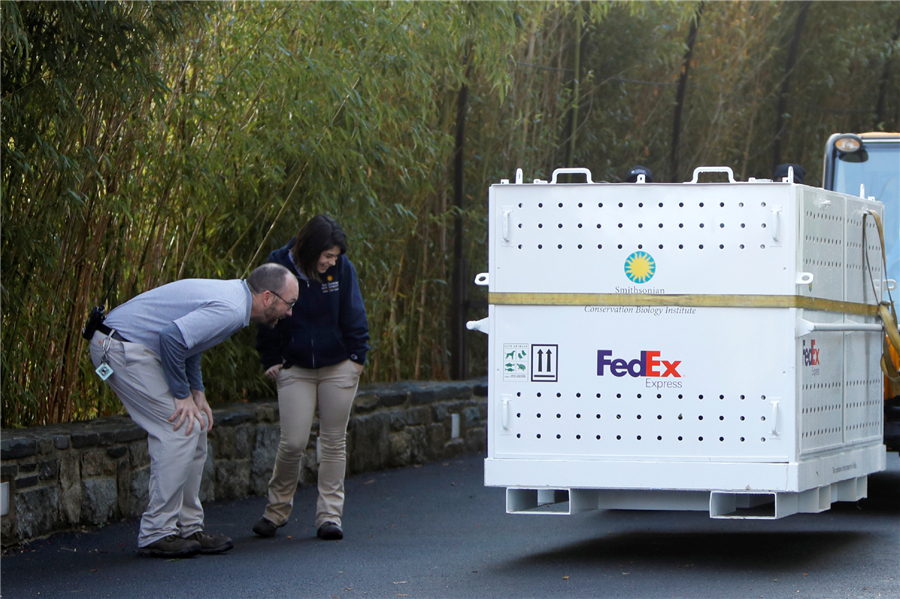
Workers look at a FedEx's crate where Bei Bei, the giant panda, has been placed before his departure to China, at the Smithsonian National Zoo, in Washington, Nov 19, 2019. [Photo/Agencies]
A special Boeing 777 Freighter provided by FedEx was flying the panda and two of the zoo's staff members-a panda keeper and a veterinarian-nonstop from Washington to Chengdu.
They will continuously monitor Bei Bei during the trip and he will travel with a supply of his favorite treats, including bamboo, apples, pears, carrots, cooked sweet potatoes, biscuits and water, the zoo statement said. The China Conservation and Research Center Base for the Giant Panda is home to 312 of the world's 600 captive pandas, the largest such population in the world. Pandas are native to the southwestern province of Sichuan and to Shaanxi and Gansu provinces in the northwest. According to the 2019 Annual Conference of the Chinese Committee of Giant Panda Breeding Techniques, held last week in Chengdu, capital of Sichuan, there are more than 1,300 wild pandas in the province, accounting for 75 percent of the national total. In 1980, an agreement between the World Wide Fund for Nature and the government led to the establishment of the China Conservation and Research Base for the Giant Panda at the Wolong National Nature Reserve in Wenchuan county, Sichuan. With bases at Hetaoping and Shenshuping in the nature reserve, another at Bifengxia, Ya'an, and one at the foot of Mount Qingcheng in Dujiangyan-all in Sichuan-the center is the world's largest panda conservation and research organization. 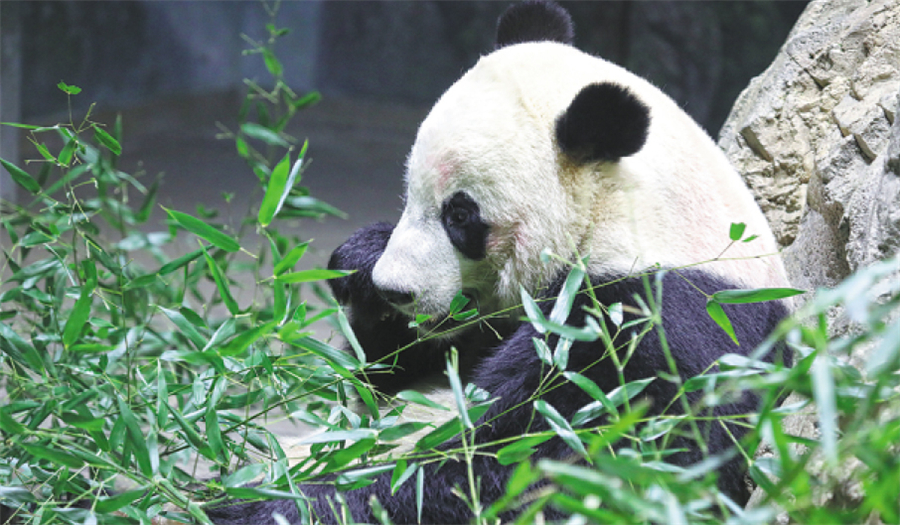
The cub eats at the zoo on Monday, a day before his departure. [Photo by Zhao Huanxin/China Daily]
In 1996, the center started loaning pandas to other countries and regions, where they have given birth to 19 cubs. Fifteen of the cubs, excluding Bei Bei, have been sent to the center. Under the agreement for global giant panda preservation, pandas born overseas belong to China and should be returned to the country when they turn 2 years old. Zhang Hemin, executive director of the center, said that in some cases, cubs are sent to China when they are older, at the request of the country in which they were born. Many cubs born overseas initially stay at the Bifengxia branch before being transferred to others administered by the center. The best-known cub to arrive at Bifengxia was Tai Shan, who was born at the Smithsonian's National Zoo in 2005. The male, who is now 14, charmed millions of visitors during his four-and-a-half year stay in the US capital. After Tai Shan arrived in China in February 2010, the center assigned a keeper with a good command of English to care for him. The panda's keeper in the US, Nicole Meese, had communicated with him in English since has was just 1 month old. The center feared that Tai Shan would be unable to understand a Chinese keeper speaking in the Sichuan dialect. But Su, Bei Bei's new keeper, said: "Pandas do not understand human languages at all, be it Chinese or English. They only recognize human voices." In June, managers at the Bifengxia base told Su that she would be caring for Bei Bei. Since then, she has learned a lot about the cub. "Pandas like sweet food. Bei Bei has been rewarded with sugarcane after cooperating in a physical checkup-for example, after he has placed one leg on equipment to enable blood to be drawn," Su said. "Instead of sugarcane, we will feed Bei Bei with honey as a reward," she added. Su plans to spend two weeks allowing Bei Bei to get to know her voice. She will also train the cub how to stand and sit.
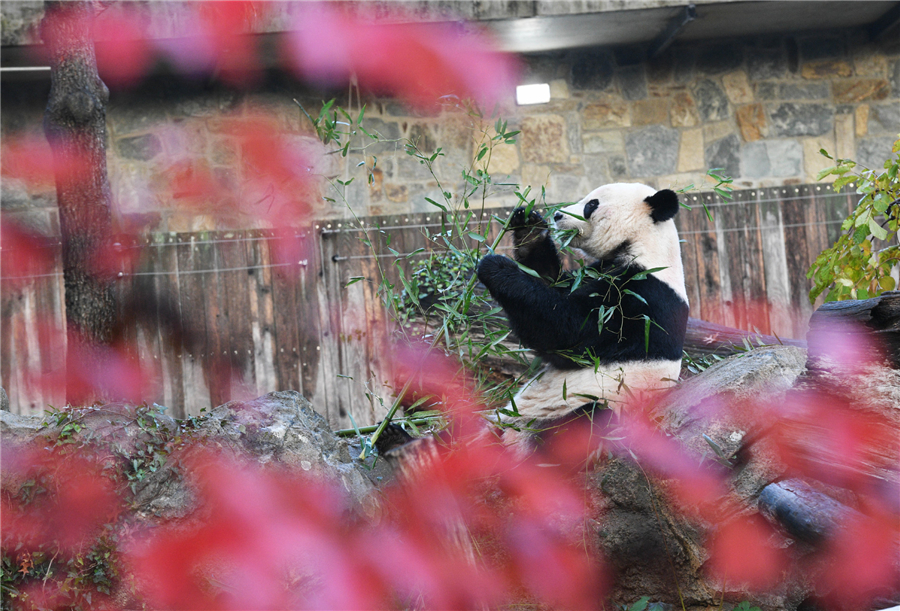
The cub eats at the zoo on Monday, a day before his departure. [Photo/Xinhua]
"Bei Bei is a male and will mate under the reproduction program. Training him how to stand will increase his stamina during mating, while sitting is the best posture for a physical checkup," she said. Su, who lives in downtown Ya'an, arrives at the Bifengxia base before 9 am each day. Her daily routine involves visiting the panda den to check on the occupant. If nothing is wrong, she cleans the den and feeds the panda four times before taking a bus just before 5 pm to the downtown area, where most employees at the base live in dormitory buildings. Her routine with Bei Bei will follow this pattern, she said. "Pandas sleep for about 12 hours a day. They wake two or three times during the night to eat and then fall asleep. I will install an app on my phone after Bei Bei arrives at the base so that I can monitor him at night from my dormitory." Pandas only eat the central part of the bamboo plant, which at this time of year is just the stalk, so they waste a lot. Visitors to the Bifengxia base can see the bamboo being transported by trucks. "Keepers at the base feed pandas bamboo, bamboo shoots, a special bun, carrots and apples. We give each panda 30 kilograms of bamboo a day, and they eat more than 10 kilograms daily, but only the best part of the bamboo," Su said.
Reporting by Huang Zhiling in Ya'an, Sichuan and Zhao Huanxin in Washington |











7740f3b5-9ecb-438e-9052-76cb2d4bb671.jpg)

